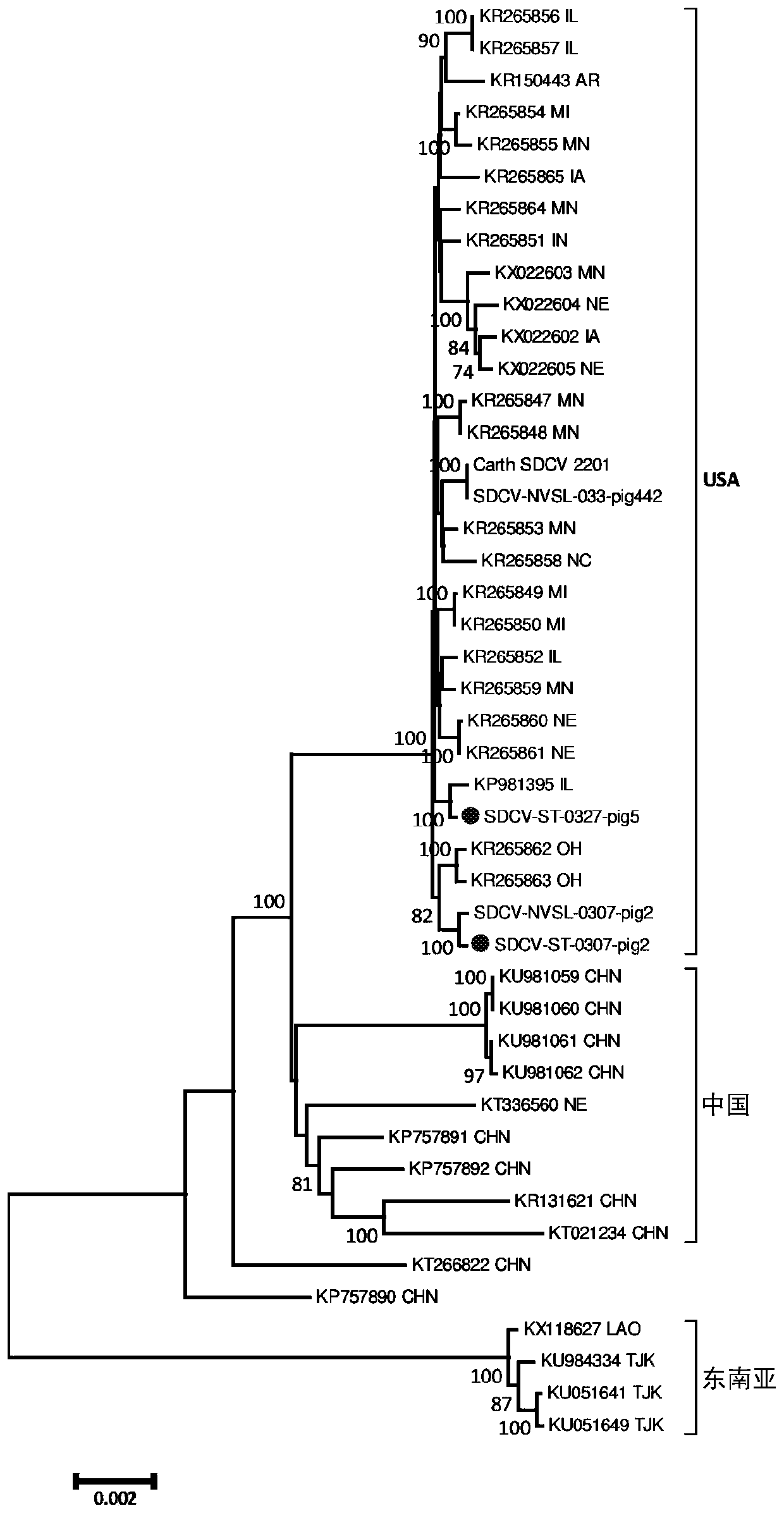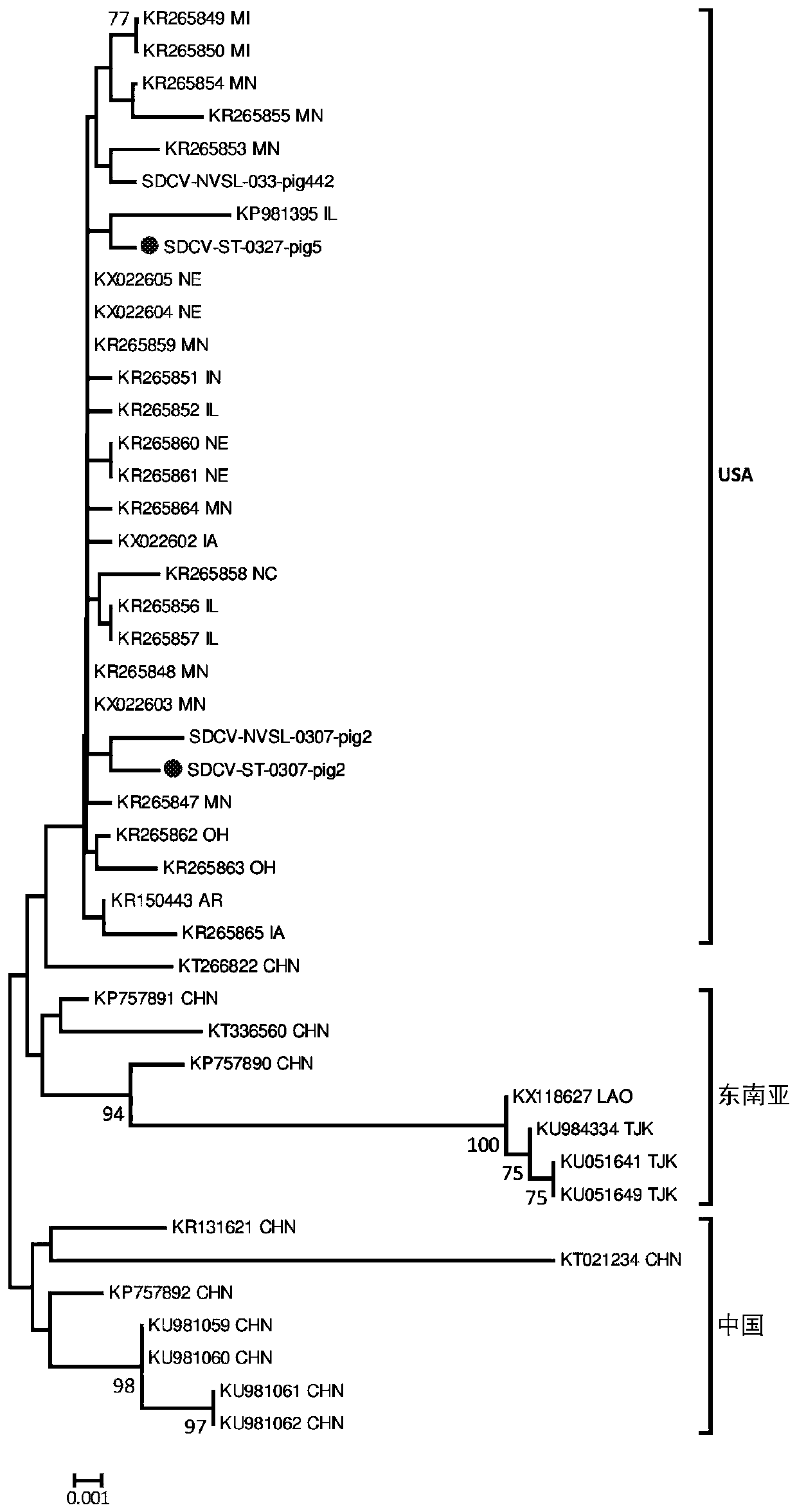Porcine coronavirus vaccines
A coronavirus, virus technology, applied in the field of combined vaccines that provide both PEDV and PDCoV antigens, can solve problems such as protection or reduction of clinical symptoms of unproven diseases
- Summary
- Abstract
- Description
- Claims
- Application Information
AI Technical Summary
Problems solved by technology
Method used
Image
Examples
Embodiment 1
[0183] Embodiment 1: Isolation and production of PEDV strain
[0184] To produce a porcine epidemic diarrhea virus vaccine, the virus is killed and a stock culture of PEDV (isolate) is first produced. PEDV cultures were grown from this stock seed and then inactivated. The inactivated virus culture is then mixed with an adjuvant in order to produce a porcine epidemic diarrhea virus vaccine. The following method was used for the production of porcine epidemic diarrhea virus vaccine.
[0185] Animals or tissues from animals exhibiting extreme diarrhea were obtained in 2013. Homogenates from mucosal scrapings were generated from these animals, filtered through a 0.2 micron syringe filter, and the filtrate was used to inoculate Vero cells (VERO). Viruses were grown in the presence of PEDV maintenance medium containing modified MEM, porcine trypsin, tryptone phosphate broth, yeast extract and HEPES buffer. Viral growth was assessed and visualized by examining characteristic sync...
Embodiment 2
[0191] Embodiment 2: Isolation and production of porcine D-coronavirus strain
[0192] Porcine D-coronavirus (PDCoV) was purchased from National Veterinary Service laboratory (NVSL), Ames, IA. The virus was isolated at NVSL from pig intestine samples from Illinois in 2014. Virus was isolated on porcine testicular (ST) cells in serum-free medium in the presence of 5 μg / mL TPCK trypsin. The original virus was subjected to two rounds of plaque purification at NVSL, and the tenth passage of virus was used as starting material.
[0193] Passage 10 virus was inoculated and adapted to porcine testicular (ST) cells at BI, maintained with PDCoV containing modified minimal essential medium with HEPES, tryptone phosphate broth, yeast extract, and porcine trypsin base. Cells were incubated at 37°C with 5% CO2 for 24-48 hours and observed for evidence of PDCoV-induced cytopathic effects. When CPE was complete and cells had detached, flasks were freeze-thawed once and lysates were harve...
Embodiment 3
[0194] Example 3: Genome sequence analysis of PEDV isolates and PDCoV isolates
[0195] Sample preparation and analysis:
[0196] Prior to extraction, viral tissue culture supernatants are pretreated with a mixture of DNase and RNase to remove residual host cell genomic nucleic acid. then use Viral RNA Extraction Kit (Qiagen, catalog #52906), for the extraction of viral genomic RNA from nuclease-treated samples. After extraction, the samples were again treated with DNase to further enrich for viral genomic RNA. Subsequently, viral genomic RNA was converted to double-stranded cDNA (ds cDNA) by randomly primed reverse transcription and Klenow fragment treatment. then use XT Library Prep Kit (Catalog #FC-131-1024), ds cDNA products are used to generate Illumina-based Sequencer for sequencing the library. Each sample is barcoded with unique tags on both the 5' and 3' ends to minimize the chance of mis-binning biological information. The library was published at The se...
PUM
| Property | Measurement | Unit |
|---|---|---|
| bioadhesion | aaaaa | aaaaa |
Abstract
Description
Claims
Application Information
 Login to View More
Login to View More - R&D Engineer
- R&D Manager
- IP Professional
- Industry Leading Data Capabilities
- Powerful AI technology
- Patent DNA Extraction
Browse by: Latest US Patents, China's latest patents, Technical Efficacy Thesaurus, Application Domain, Technology Topic, Popular Technical Reports.
© 2024 PatSnap. All rights reserved.Legal|Privacy policy|Modern Slavery Act Transparency Statement|Sitemap|About US| Contact US: help@patsnap.com










